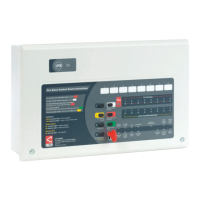
Do you have a question about the C-TEC AlarmSense CFP702-2 and is the answer not in the manual?
| Type | Conventional Fire Alarm Control Panel |
|---|---|
| Number of Zones | 2 |
| Input Voltage | 230V AC |
| Frequency | 50 Hz |
| Battery Size | Up to 7Ah |
| Operating Temperature | -5°C to +40°C |
| Approval | EN54-2 & EN54-4 |
| Weight | 3.5kg |
| Standards | EN54-2/4 |
Details AlarmSense™ zone circuits, wiring, and device compatibility.
Describes the four conventional sounder circuits for external sounders.
Covers user access levels and available engineering functions.
Crucial instructions for skilled personnel, handling of manual.
Recommends consulting qualified persons for system design and standards.
Outlines conditions for equipment guarantee based on installation.
Specifies indoor installation, height, and positioning for visibility.
Step-by-step guide to remove Main Control and Power Supply PCBs.
Essential precautions for handling static-sensitive electronic components.
Details cable requirements, screening, and glanding for EMC compliance.
Specifies mains supply wiring, cable size, and earthing.
Guidance on planning cable entry points and segregation from mains voltage.
Details number of circuits and maximum devices per circuit.
States AlarmSense™ device compatibility and sounder status programming.
Details the connection of EOL capacitors for circuit monitoring.
Explains wiring for conventional sounders, EOL resistors, and polarity.
Specifies maximum total sounder current and per-zone limits.
Advises distributing sounder load equally across circuits.
Describes ALERT input (intermittent) and CLASS CHANGE input (continuous).
Details RESET, REMOTE, AUX 24V, AUX, and FAULT outputs and their functions.
Advises on using suitable relays and avoiding door holder circuits.
Guides on checking circuits and installing Power Supply PCB safely.
Instructions for mains connection and safe installation of standby batteries.
Routing mains cable, segregating, and connecting PSU earth strap.
Warning about live voltages present under covers.
Shows how to arrange and secure batteries of different sizes.
Details connecting battery leads to the Power Supply PCB.
Guides on PCB placement, connecting cables, and optional expansion devices.
Advises careful reconnection of 5mm connector blocks and labelling for clarity.
Directs to relevant pages for typical zone and sounder circuit diagrams.
Instructions for connecting auxiliary cables to the Main Control PCB.
Explains proper earthing of screens using the base distribution post.
Describes General User (Lvl 1), Authorised User (Lvl 2), and Engineer (Lvl 3) controls.
Lists functions like coincidence, delays, and fault diagnosis available to engineers.
Explains the non-EN54-2 compliant coincidence feature for zone pairs.
Details the non-EN54-2 compliant feature for zones that don't retain alarm state.
How to set delays (1-10 mins) for sounders and outputs, and override conditions.
Describes the 'one man walk test' facility for commissioning and maintenance.
How to configure sounders to resound or not resound on new alarms, and fit status.
How to use buttons like ACCESS LEVEL THREE FUNCTIONS and NEXT OPTION.
How to access level 2 controls even with the lid removed.
Step-by-step guide to setting up zone pairs for coincidence mode.
Steps to configure zones for non-latching operation, noting non-compliance with EN54-2.
Detailed steps for setting delay periods for zones, remote, and auxiliary outputs.
Guide to setting zones for testing and the required pre-test action.
How to configure sounder resound behavior and sounder fitting status per zone.
Explains General Fault, Supply Present lights and their basic meanings.
Lists potential causes for a Power Supply Fault indication.
Describes indications for system issues and repeater communication faults.
Details fault indications for sounder circuits and remote output.
Steps to diagnose detector head removal, open, and short circuit faults.
Recommended actions for correcting zone wiring faults.
Symptoms and actions for low mains voltage, fuse rupture, or PSU failure.
Symptoms and suggested actions for a ruptured battery fuse.
Explains faults due to low voltage, deep discharge, or battery condition.
Addresses scenarios where the Supply Present light is not lit.
How to identify Watchdog, Site Memory, or PLL faults and their resolution.
Provides the formula to calculate required battery capacity for standby time.
Defines quiescent current (P), zone device current (Z), and alarm current (A).
Illustrates battery capacity calculations with practical examples.
Details voltage, current, fuses, and battery requirements for the power supply.
Covers circuit numbers, cable length, monitoring, impedance, and device limits.
Lists specs for conventional sounder circuits, EOL resistors, and fuses.
Details specifications for auxiliary outputs and inputs.
Covers product dimensions, construction, IP rating, and operating environment.